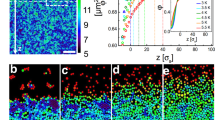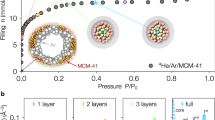Abstract
KAMERLINGH ONNES1 observed in 1922 that the surfaces of two volumes of liquid helium II, that is, helium below the λ point, in two concentric vessels adjusted themselves automatically to the same level. No further observations of this strange 'distillation' phenomenon appear to have been made in Ley den or elsewhere. Rollin2, however, found that the loss from vessels containing liquid helium II is exceptionally high, and he attributed this to some effect connected with the formation of a thin layer of helium II on the inner walls of the connecting tube. This, he suggested, might be connected with the above-mentioned phenomenon. We have lately carried out experiments with various arrangements of vessels in order to reproduce the effect observed by Kamerlingh Onnes and to investigate it systematically.
This is a preview of subscription content, access via your institution
Access options
Subscribe to this journal
Receive 51 print issues and online access
$199.00 per year
only $3.90 per issue
Buy this article
- Purchase on Springer Link
- Instant access to full article PDF
Prices may be subject to local taxes which are calculated during checkout
Similar content being viewed by others
References
Kamerlingh Onnes, H., Comm. Leiden, 159.
Rollin, B. V., Actes 7. Cong. int. du Froid, 1, 187; Prof. Simon informs us that a full account will be published shortly.
Allen, J. F., and Misener, A. D., NATURE, 141, 75 (1938).
Author information
Authors and Affiliations
Rights and permissions
About this article
Cite this article
DAUNT, J., MENDELSSOHN, K. Transfer of Helium II on Glass. Nature 141, 911–912 (1938). https://doi.org/10.1038/141911a0
Issue Date:
DOI: https://doi.org/10.1038/141911a0
This article is cited by
-
The Role of Substrate Roughness in Superfluid Film Flow Velocity
Journal of Low Temperature Physics (2019)
-
The Discovery of Superfluidity
Journal of Low Temperature Physics (2007)
-
Critical temperature and critical current of thin-film superfluid3He
Journal of Low Temperature Physics (1988)
-
Der gegenwärtige Stand des Helium-II-Problems
The Science of Nature (1949)
Comments
By submitting a comment you agree to abide by our Terms and Community Guidelines. If you find something abusive or that does not comply with our terms or guidelines please flag it as inappropriate.



